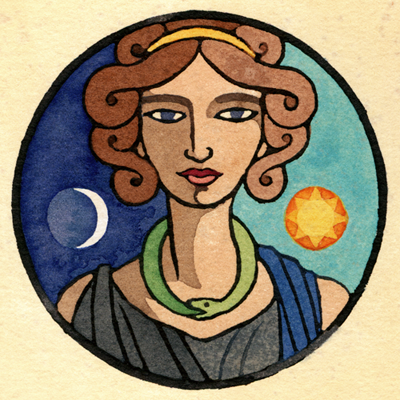 Aeternitas, ink on illustration board; the original is about three inches across. 
Aeternitas, or Eternitas, is the Roman Goddess Who is the personification of eternity. She seems to be a somewhat late addition to the Roman pantheon, and was featured on many coins of the Imperial era. Like other abstract concepts which were made into Goddesses, Aeternitas was often used as an attribute of the Emperor or Imperial family as a sort of public relations maneuver. She symbolized the stability and (hopefully) eternal staying power of the Empire, and could also be used to commemorate members of the Imperial family who had died and been deified, as a sign that after deification they were considered eternal, and as a declaration that they would never be forgotten. Aeternitas could be depicted in many ways with a variety of attributes, most of them clearly symbolizing the everlasting. Commonly She is shown holding the rayed sun and crescent moon in either hand, or the heads of the Sun-God Sol and the Moon-Goddess Luna. As the lights of the day and night they represented time; additionally the ancients thought that the sun and moon were eternal and everlasting, and though modern science knows better now, 5 billion years (the time it will take for the sun to become a red giant and swallow up the earth) is still pretty close to eternity, from the human point of view. Aeternitas was often shown with a globe, either holding it or seated upon it; the globe, too, as a circle or sphere, symbolizes eternity as well as completeness, and is a symbol of dominion appropriate to an Empire. Sometimes a phoenix is shown with Her or standing upon the globe: this mythical bird represented immortality and longevity, as it was said to periodically immolate itself in a fire from which it emerged renewed. Most of the little phoenixes on the coins look rather like ducks or geese, though some bear a fiery halo; on one coin from 284 CE, the phoenix resembles a crane rather more, which is not too surprising since the Egyptian prototype, the Benu-bird, was shown as a grey heron. To the Romans, the phoenix was used as a symbol specifically representing the constant rebirth of the Empire and the deification of its Emperor. Other objects shown with Aeternitas include a torch, which in Roman culture has funerary connotations, and represents the light of the (eternal) afterlife, in this case in reference to deified Emperors or their family members; the cornucopia, representing endless abundance; the sceptre, meaning authority, perhaps of the Emperor himself; and the ouroboros, the snake which bites its own tail, symbolising immortality and the eternal cycles of time. She can be shown wearing a helmet, like Minerva, or with a crown, also a symbol of eternity due to its circular shape. She can be seated or standing, and sometimes is shown leaning against a column, representative of stability. Though Aeternitas had no temple or altars to Her, the Emperor Nero (the 1st century Emperor who traditionally played the "fiddle" while the fire he set destroyed Rome) did establish games dedicated to the "Eternity of the Roman Empire"; though these games were probably more a patriotic celebration than anything else, I'd guess that Aeternitas did play some part in them and was honored at the festival. |
|
|



